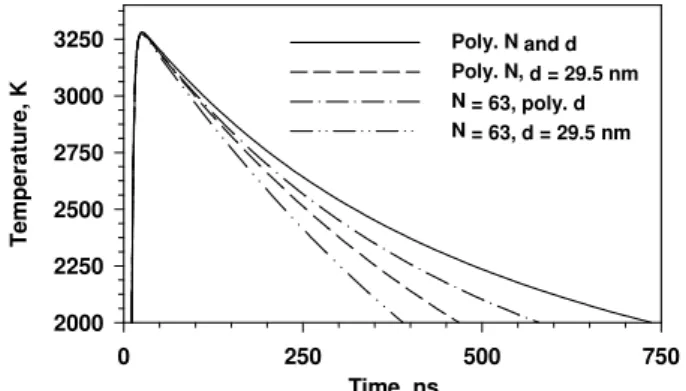Publisher’s version / Version de l'éditeur:
Proceedings of the International Bunsen Discussion Meeting 2005., 2005
READ THESE TERMS AND CONDITIONS CAREFULLY BEFORE USING THIS WEBSITE. https://nrc-publications.canada.ca/eng/copyright
Vous avez des questions? Nous pouvons vous aider. Pour communiquer directement avec un auteur, consultez la
première page de la revue dans laquelle son article a été publié afin de trouver ses coordonnées. Si vous n’arrivez pas à les repérer, communiquez avec nous à PublicationsArchive-ArchivesPublications@nrc-cnrc.gc.ca.
Questions? Contact the NRC Publications Archive team at
PublicationsArchive-ArchivesPublications@nrc-cnrc.gc.ca. If you wish to email the authors directly, please see the first page of the publication for their contact information.
NRC Publications Archive
Archives des publications du CNRC
This publication could be one of several versions: author’s original, accepted manuscript or the publisher’s version. / La version de cette publication peut être l’une des suivantes : la version prépublication de l’auteur, la version acceptée du manuscrit ou la version de l’éditeur.
Access and use of this website and the material on it are subject to the Terms and Conditions set forth at
Influence of polydisperse distributions of both primary particle and
aggregate sizes on soot temperature in low-fluence laser-induced
incandescence
Liu, F.; Yang, M.; Hill, F. A.; Smallwood, G. J.; Snelling, D. R.
https://publications-cnrc.canada.ca/fra/droits
L’accès à ce site Web et l’utilisation de son contenu sont assujettis aux conditions présentées dans le site LISEZ CES CONDITIONS ATTENTIVEMENT AVANT D’UTILISER CE SITE WEB.
NRC Publications Record / Notice d'Archives des publications de CNRC:
https://nrc-publications.canada.ca/eng/view/object/?id=d4be9b84-facb-45cd-879f-399dd070a96e https://publications-cnrc.canada.ca/fra/voir/objet/?id=d4be9b84-facb-45cd-879f-399dd070a96e14 Monday, Sept. 26, 10:00
Influence of polydisperse distributions of both primary particle and aggregate
sizes on soot temperature in low-fluence laser-induced incandescence
F. Liu1, M. Yang1, F. A. Hill2, G. J. Smallwood1*, and D. R. Snelling1
1ICPET, National Research Council Canada, Ottawa, Ontario, Canada 2
Department of Systems Design Engineering, University of Waterloo, Waterloo, Ontario, Canada
An improved aggregate-based low-fluence laser-induced incandescence (LII) model was developed. The shielding effect on the heat conduction between aggregated soot particles and the surrounding gas was modeled using the concept of the equivalent heat transfer sphere. The diameter of such equivalent sphere was determined from detailed direct Monte Carlo simulation in the free molecular regime as functions of the aggregate size and the thermal ac-commodation coefficient (TAC) of soot. The effect of primary particle diameter polydispersity is in general important and should be considered. The effect of aggregate size polydispersity is relatively unimportant when the heat conduc-tion between the primary particles and the surrounding gas takes place in the free-molecular regime; however, it becomes important when the heat conduction process occurs in the transition regime. Application of the model was also applied to re-determine of the TAC of soot in an atmospheric pressure laminar ethylene diffusion flame.
* Corresponding author: greg.smallwood@nrc-cnrc.gc.ca
Proceedings of the International Bunsen Discussion Meeting 2005: Laser-Induced Incandescence, Quantitative interpretation, mod-elling, application
Introduction
It is shown by thermophoretic sampling/trans-mission electron microscopy techniques that flame-generated soot consists of polydispersed primary particles and aggregates. There is currently lack of a quantitative understanding of the shielding effect on heat conduction between aggregated soot par-ticles and the surrounding gas. This study made an attempt to develop an aggregate based low-fluence LII model to investigate the shielding effect and examine the implication of such effect to LII based particle sizing techniques.
LII Model
The low-fluence LII model formulated for a soot aggregate was developed by introducing the con-cept of heat conduction equivalent sphere. The diameter of such sphere was determined from detailed direct Monte Carlo simulation in the free molecular regime as functions of the aggregate size and the TAC of soot. Heat conduction loss rate from the soot aggregate to the surrounding gas was calculated using the Fuch’s approach. The distributions of the primary particle diameter and the aggregate size were assumed log-normal.
Results
The relative importance of aggregate size (N) and primary particle diameter (d) distribution under conditions of a typical flame, where heat condition occurs in the free-molecular regime, is shown in Fig. 1. It shows that the polydispersity of aggregate size is relatively unimportant while the polydisper-sity of primary particle diameter is more important.
Fig. 2 shows the relative importance of the dis-tribution of N and d under the condition of a low gas temperature where the heat conduction takes place in the transition regime. While the polydis-persity of d is still more important that that of N, the effect of polydispersity of N becomes more pro-nounced compared to the results shown in Fig.1.
The results shown in Fig. 2 implies that the LII based nanoparticle sizing techniques for primary particle diameter measurement suffers ambiguity when applied to situations where the polydispersity of N is significant. Time, ns 0 250 500 750 1000 T e mpe rat ur e, K 2200 2400 2600 2800 3000 Poly. N and d Poly. N, d = 29.5 nm N = 63, polydisp. d N = 63, d = 29.5 nm
Fig. 1 Relative importance of N and d distributions in the flame case: Tg = 1720 K. Time, ns 0 250 500 750 T emper at u re, K 2000 2250 2500 2750 3000 3250 Poly. N and d Poly. N, d = 29.5 nm N = 63, poly. d N = 63, d = 29.5 nm
Fig. 2 Relative importance of N and d distributions in the low gas temperature case: Tg = 440 K.
Application of this aggregate based low-fluence LII model to analyze our data found that the TAC of soot to be 0.38.
